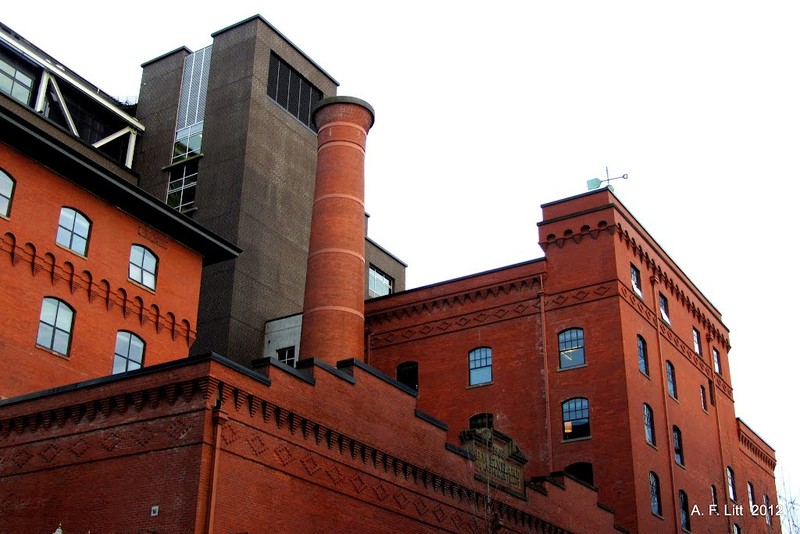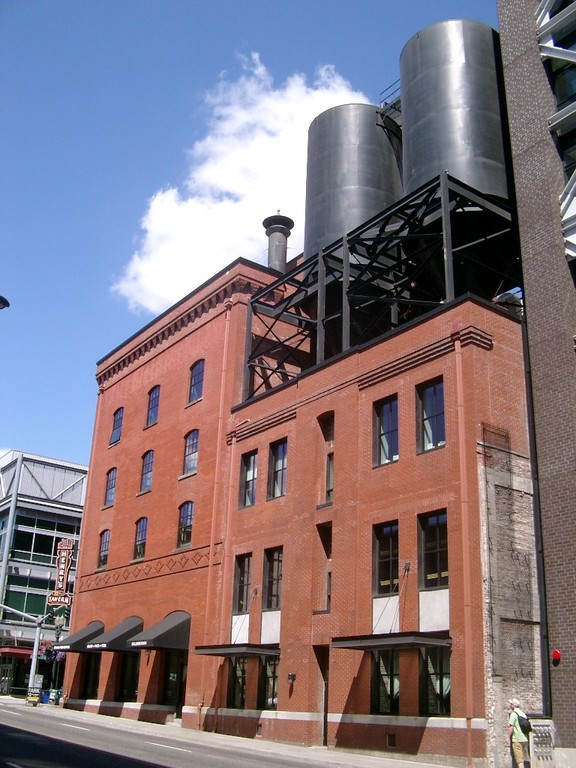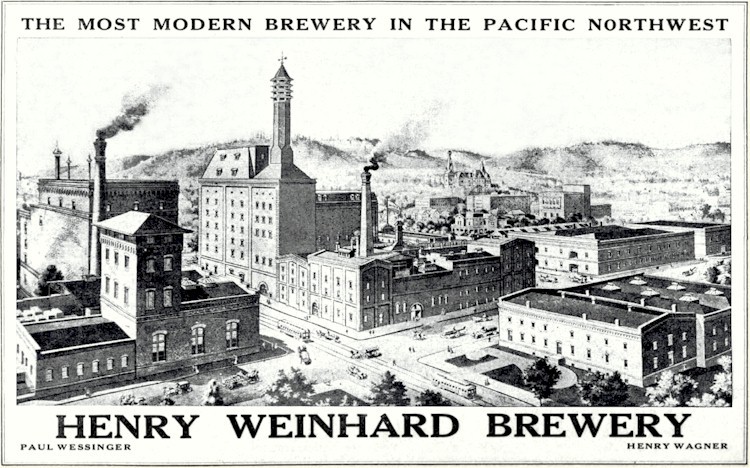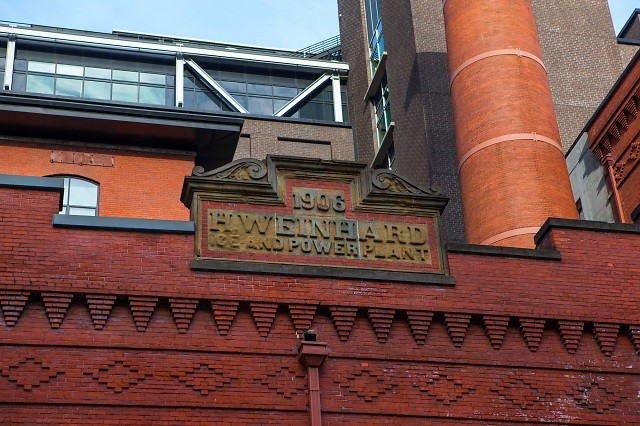Henry Weinhard Brewery/Blitz-Weinhard Brewery (Portland Brewery Blocks)
Introduction
Text-to-speech Audio
This historic five-building complex once housed the Weinhard City Brewery (or Weinhard Brewery). A German Immigrant with a brewing background, Henry Weinhard arrived in the U.S in the 1850s. By the turn of the 20th century, had amassed a fortune selling beer in the Pacific Northwest. Weinhard established his brewery at this location in 1862. The brewery merged with the Blitz Brewing Company in 1928. Today, part of the complex is once again home to a local brewery.
Images
Once home to the Weinhard Brewery, the building complex now boasts retail outlets, restaurants, and a local brewery.

The former home of the Blitz-Weinhard brewery is now home to Portland's Brewery Blocks

A historic image of the brewery from the website Brewerygems

The building retains many of the original features along with this sign.

Backstory and Context
Text-to-speech Audio
Henry Weinhard's City Brewery, now part of a modern day five-block shopping and professional district in Portland’s Pearl District, existed as a prominent 19th-century brewery operated by longtime Portland businessmen Henry Weinhard, and later by Paul Wessinger. Weinhard, a German immigrant, arrived in the U.S. in the 1850s and started a brewery in 1862 that quickly succeeded and rapidly expanded. Upon his death in 1904, Paul Wessinger took over the operations of the brewery and carried out plans to build the Weinhard Brewery Complex as part of the brewery's last significant expansion -- that is the building that remains today. The building represented the brewery's 19th-century success, but also the peak of its prominence. By 1928, the brewery merged with the Blitz Brewing Company (just before Prohibition). The rise of the brewery is not unlike many Gilded Age stories, filled with innovation, skill, good timing and shrewd business tactics.
The complex consists of five distinct buildings that are connected by one common architectural style - the brick industrial construction and Romanesque style commonly found in Portland buildings after the city's successful Lewis and Clark Exposition.
Henry Weinhard emigrated to the U.S. as a 27-year-old from Lindenbronn, Werternberg, Germany in the 1850s and eventually amassed a fortune with the formation of his Pacific Northwest brewing business. Before arriving in the region, Weinhard worked as a brewing apprentice in his German homeland and worked at a brewery in Cincinnati, Ohio and then moved to San Fransisco in 1856. He later moved to Vancouver, Washington where he took a job a Meunch Brewery. He used his life savings to purchase that brewery. Also while in Vancouver, Weinhard met his wife, Louisa Waggonblast, who was also from Werternberg, Germany. The two wed on January 27, 1859, and went on to have five children. Similar to other couples at the time, only two of the children survived to adulthood.
In 1862, the U.S. Civil War affected business for Weinhard's Vancouver brewery as the soldiers that had previously been stationed at Fort Vancouver left to fight the war. Weinhard sold his Vancouver brewery to Anton Young, also a German native, and moved to Portland, Oregon in search of thirsty customers. Weinhard and other entrepreneurs recognized that Portland was growing rapidly. Weinhard first purchased the Saxer's Liberty Brewery and then, one year later, the Bottler Brewery, eventually renaming the operations, "City Brewery." Along with his partner William Dellinger, the company advertised not only its lager beer but also malt, hops, Irish moss, barley, shovels, barrel brushes, brass and wood facets. Rapid success resulted in quick expansion, which continued through the 1890s -- Weinhard shipped beer to Eastern Oregon, Washington, and Montana, and all along the West Coast. The brewery quickly became one of the leading businesses in the Portland area.
Weinhard's success and concurrent financial gain offered him the opportunity to explore other business ventures, such as building the Grand Central Hotel Weinhard and Arion Hall in 1889 (demolished in 1930) which was Portland's only concert hall for many years. Typical of the 1890s, brewery owners, restaurant ownership, and saloon operations went hand-in-hand, and didn't always involve noble business tactics, Always the shrewd businessman, Weinhard offered loans to those starting new restaurants, and those establishments would then send Weinhard's brew. In other words, the loans served as investments.
Moreover, In 1903, Weinhard also financed the construction of a business block in downtown Portland called the Weinhard Block and managing numerous saloons, rumored to offers many "vices." Not atypical of the day, saloons often offered various "services," as a means of drawing clientele and allowing for increased beer sales. In fact, many private saloon owners felt pressure from brewing entrepreneurs to sell substantial amounts of beer. Thus gambling and prostitution proved to be a smart (if not necessary) ploy to gain clientele. Indeed, the city's vice committee included him on an unpublished list of offenders. The Oregonian never published the list because with fifty prominent Portland businessman's name included, the editor felt it would not be good for the city's success. Newspapers of this era often served as public relation firms for the cities they served, including protecting businesses.
Henry Weinhard died on September 20, 1904, at the age of 74 of a heart attack.Weinhard passed the family business to Paul Wessinger, his son-in-law, who continued to operate the business for the next 20 years.
The City Brewery's initial growth and expansion through the 1890s coincided with Portland's growth, which saw an even bigger boom in the first two decades of the 20th century. Portland's population more than doubled from 8,300 in 1870 to 17,600 in 1880. As the 2nd Industrial Revolution emerged, so did improved forms of communication and transportation (and shipping), allowing for an expanded marketplace and greater ease for which to market one's product. The City Brewery resembles that aspect of American, and Portlandian, life, as it does the brewing prowess of Weinhard. The building that stands reminds us of that era where immigration, migration, industrialization, commercialization, consumption and transportation transformed the country into a lifestyle that dominated much of the 20th Century.
Sources
Ingraham, Aukjen Tadema. "Henry Weinhard: Portland's Elusive Founding Father". Whitman College Thesis. Walla Walla, Washington: Whitman College, 1998.
Ogle, Maureen. Ambitious brew: The Story of American Beer. New York: Houghton Mifflin Harcourt, 2007. Part of this book involves a discussion regarding the relationship between saloons and breweries, an often highly-pressured and tumultuous relationship.
Steinberg, Ted. Acts of God: The Unnatural History of Natural Disaster in America. New York: Oxford University Press, 2006. This book notes the many times where city newspapers covered spun controversies into positives, or covered up scandals, for the purposes of acting as city boosters.
Tess, John M. "National Register of HIstoric Places Nomination Form." National Parks Service, December 01, 1999. https://npgallery.nps.gov/pdfhost/docs/NRHP/Text/00001018.pdf
